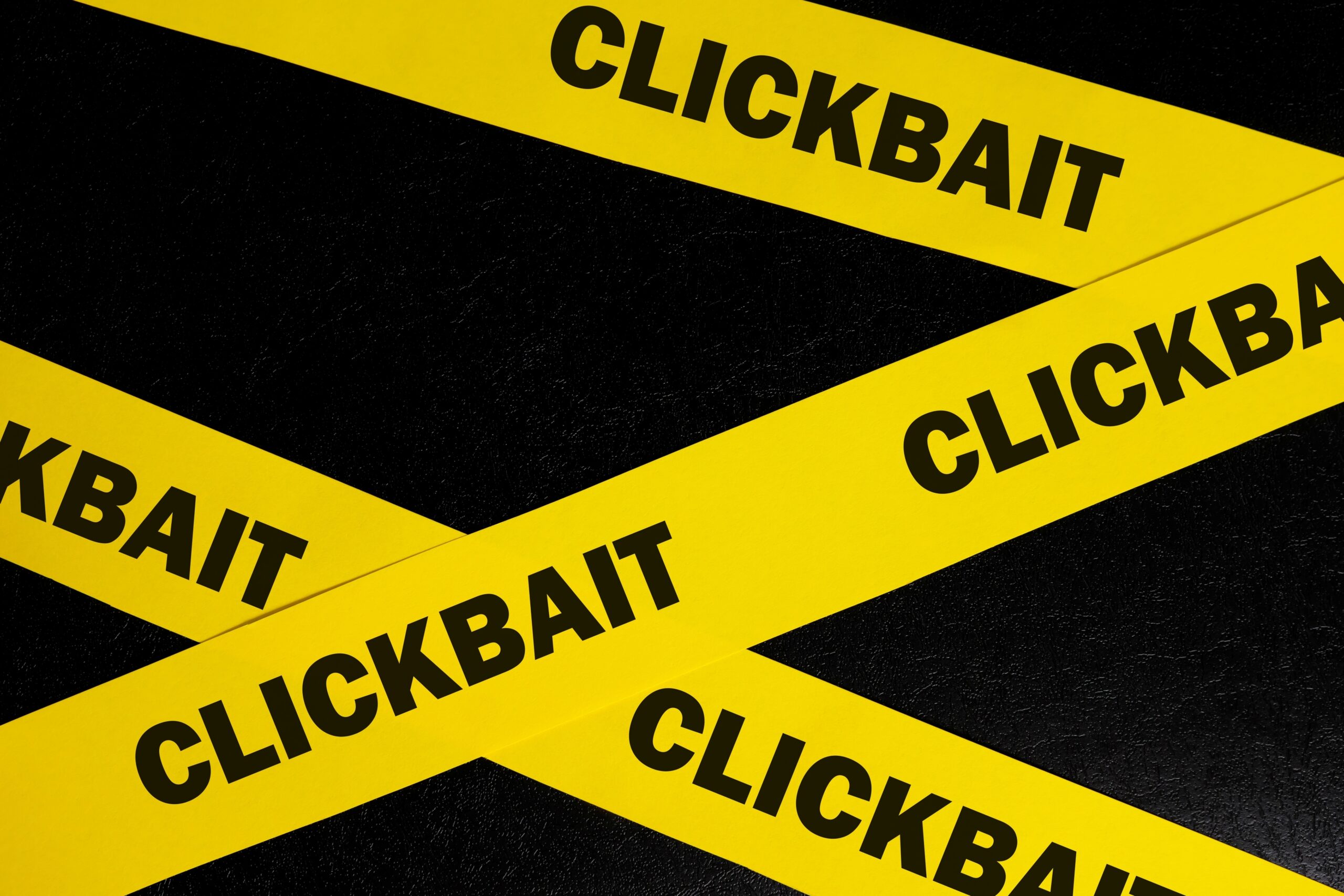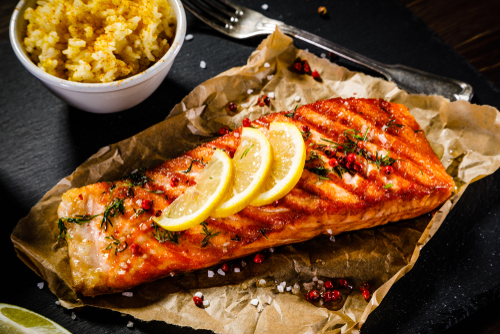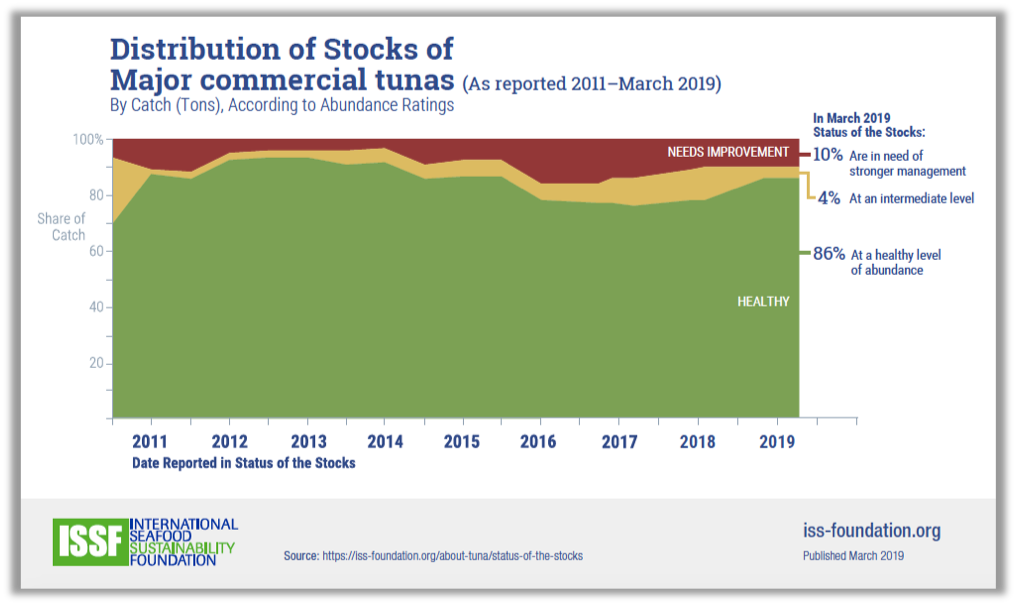All posts by NFI
Students at UC Santa Cruz Need to Eat More Tuna, Not Less: Administrators Get It Wrong
Imagine sitting in your college dining hall. Your roommate sits down across from you with a bowl of marshmallow-festooned cereal, a slice of pizza, a cheeseburger, and some ice cream. As he announces that he is redistributing the pepperoni on his slice so there is a bit in every bite, he looks at your meal in horror. “Don’t you realize that’s unhealthy?” he asks, motioning to the marinated albacore in your salad.
University of California Santa Cruz “Study” is Flawed
This scenario just got a whole lot more real recently when University of California Santa Cruz administrators took the absurd step of announcing labels on tuna products in dining halls with warnings about the “risks” of consuming tuna that could contain mercury. The move comes after an activist, who is now an adjunct professor at the school, released a survey of tuna consumption by students that purportedly found “raised” mercury levels in some.
But the UC Santa Cruz study is flawed and unscientific. It sampled 61 students over just two months during two different years, too small a number over too brief an interval to draw substantive conclusions, let alone build policy around. And nutrition studies based on self-reporting are often inaccurate, given that people’s guesses about their food consumption are skewed—can they be certain, for example, the fish they ate was tuna? What kind?
On top of the poor research quality, the clear bias of the lead researcher should dismiss her findings. Myra Finkelstein is currently an adjunct associate professor at UC Santa Cruz. She is also a board member of Turtle Island Restoration Network, creators of a project designed to scare consumers away from eating seafood called “Got Mercury?” Prior to this, she was a part of the group Sea Shepherd Conservation Society, which was founded by a Greenpeace alum and even labeled an “eco-terrorist” group by the Japanese government. This severe conflict should have been disclosed in the study. Finkelstein does not appear to be a dispassionate researcher.
Seafood 101
The reality is that there has never been a single case of mercury poisoning from normal commercial seafood consumption documented in any U.S. medical journal. A team of scientists and FDA advisors reviewed an exhaustive body of research on mercury risk compared to the beneficial nutrients in fish. They strongly concluded that “consistent evidence shows that the health benefits from consuming a variety of seafood in the amounts recommended outweigh the health risks associated with methyl mercury” (USDA/HHS Dietary Guidelines for Americans).
Make no mistake: Tuna is healthy. UC Santa Cruz officials are letting bad science guide policy decisions that will cause their students real harm.
The USDA’s Dietary Guidelines for Americans urges consumers to eat more fish, including tuna. Why? Because seafood’s omega-3 fatty acids, lean proteins, vitamins, minerals strengthen the heart and brain. Growing bodies need proteins and omega-3s play an essential part in healthy brain and eye development. The USDA also recommends that Americans eat at least two to three servings of seafood per week.
So what happens if students listen to administrators who base these decisions of a single, flawed study? They’ll fall into the same trap that the FDA has warned about, that most Americans are eating dangerously low amounts of seafood, a deficiency they say contributes to nearly 84,000 preventable deaths each year. Another long-term study showed that children whose mothers ate three to four servings of fish a week had IQ scores that were 2.8 percent higher than those whose mothers ate less fish.
Studies like the ones at UC Santa Cruz are precisely what the National Academy of Sciences had in mind when they found that distorted and alarmist information is leading to reduced consumption of the very kinds of food students should be eating.
If you don’t put sound science first, you put students at risk. Let the students maintain a healthy diet. Let them eat their tuna in peace.
Latest News
Note to Reporters: Stop Needlessly Scaring Consumers
Some opportunistic bloggers and click-bait reporters are using a new study on climate change and mercury to scare consumers away from eating seafood. It’s the same sad song and dance we’ve seen time and again from irresponsible voices who’d rather grab eyeballs than actually help inform the public.
Here’s what you really need to know about the study:
- As we already detailed in this blog post, the study is not about people, or human seafood consumption. The researchers looked exclusively at mercury levels in fish, not human beings who eat fish.
- The amounts of mercury in fish measured by the researchers were well within the safety limits set by the FDA.
- There is no reason for the authors to mention canned or pouched tuna. The research did not look at the most commonly consumed tuna products: Canned and pouched varieties that predominantly come from skipjack, albacore, and occasionally yellowfin (which is identified on product labels). Yet the introduction to the study claims mercury exposure can come from fresh and canned tuna, even though there has never been a confirmed case of mercury poisoning in any U.S. medical journal. So why bring tuna into it at all? Perhaps because the authors know that tying their research to a common consumer product will give uncareful journalists a hook for their coverage. And wouldn’t you know it, nearly every piece on the study mentions the spurious tuna “connection.”
Here are some specific examples: Discover Magazine included the phrase “making seafood more toxic” in their headline – even though the study had nothing to do with nutrition and mercury levels reported were still well within the safety margins. The blog Medical News Today used a similar ploy with the non-sequitur headline “Why fish may become more toxic than ever.”
Environmental activist blog Grist drew its own spurious conclusions, writing “Climate change is making it more dangerous to eat certain fish.” What they left out is that Americans are already eating dangerously low amounts of seafood, contributing to a public health crisis. So consumers should be eating more seafood, not less.
But the Daily Mail might take the prize for scare-mongering theatrics with this ridiculous headline: “Is this the end of fish and chips? Soaring levels of mercury in the world’s oceans could make COD too dangerous for humans.”
Ordinary readers scanning these headlines wouldn’t be unreasonable to conclude that ordering tuna salad or fish tacos for lunch might put their health at risk. When in fact the opposite—avoiding seafood in favor of other sources of protein—is far closer to the truth.
Seafood like canned and pouched tuna are nutritious, affordable, and safe. Tuna and other seafood are rich in key nutrients like vitamins B12 and D, iron, zinc, magnesium, phosphorous, selenium, and beneficial omega-3s called EPA and DHA. You can read all about these benefits here.
Virtually every major health organization in the United States urges consumers to eat more seafood as part of a healthy diet. In the “Dietary Guidelines for Americans,” the federal government recommends that everyone should increase their consumption of seafood, and that pregnant women in particular eat at least 2 to 3 servings each week.
A comprehensive study from Harvard, focused on nutrition and public health, showed that some 84,000 cardiac-related deaths could be prevented each year with proper servings of fish in the diet. And reams of independent research have shown that seafood is vital for cognitive development in growing children, associated with as much as a 3-point boost in IQ.
And that’s the bottom line: Sensationalist reporting that skews the facts is not just bad for your mind—it’s bad for your brain.
Latest News
Salmon Nutrition: Everything You Need to Know About Salmon
Known for its pink color, health benefits and versatility, salmon has been at the center of the seafood world for years. From commonly eaten species and salmon nutrition information to the farmed vs. wild debate, find everything you need to know about salmon here.
Types of Salmon
Salmon is primarily classified in one of two main categories: Pacific and Atlantic. The Atlantic salmon found in supermarkets and restaurants is farmed; its wild counterpart is protected under the Endangered Species Act, so commercial fishing of Atlantic salmon is prohibited in the United States. Meanwhile, species within the Pacific salmon category are by and large wild-caught from the west coast of the U.S., primarily from Alaska. Within the Pacific salmon category, the most commonly eaten species for salmon nutrition are Chinook, Pink, Chum, Coho and Sockeye.
- Atlantic: Atlantic salmon is farm-raised all over the world. Like wild-caught salmon, their flesh is reddish-orange or pink. Atlantic salmon have a high oil content and firm, fatty texture. Historically, Atlantic salmon are spawned and raised in on-land hatcheries until they are large enough for transfer to net-pens in coastal waters. More recently, however, companies have developed land-based farming operations from spawning through harvest.
- Chinook: Chinook salmon, commonly referred to as King salmon, is the largest of the species wild-caught in the Pacific, weighing twenty pounds on average. Chinook have a bold flavor, high fat content and a buttery, flaky texture. Their meat is red.
- Sockeye: Sockeye salmon is known for its rich flavor and has the reddest flesh of the wild salmon species. Almost all the sockeye salmon commercially harvested in the United States comes from Alaska fisheries. Sockeye is firm and fatty.
- Pink: Pink salmon is the smallest but most abundant species wild-caught in Alaska, and to a smaller extent Washington and Oregon. Pink salmon typically weighs between two and three pounds. It has a lower oil content, which makes it a leaner and mild-flavored fish with soft, pale pink meat.
- Chum: There are hundreds of stocks of Chum salmon in Alaska and several other Pacific stocks. Chum salmon, also called Keta, have a firm and meaty texture, making them ideal for smoking or grilling. Chum salmon has lower oil content, which gives it a mild flavor.
- Coho: Coho salmon is known for its orange flesh and is the second largest of the wild Alaska salmon species. Coho salmon has a high oil content and becomes firm and flaky when cooked.
Salmon Nutrition
Salmon is one of the most nutrient-packed foods you can eat. A three-ounce serving is rich in protein, vitamin B12, selenium and healthy omega-3 fatty acids. Omega-3s are essential to eye, brain, and heart health. Omega-3s, specifically eicosapentaenoic acid (EPA) and docosahexaenoic acid (DHA) found in salmon, are crucial for brain growth and development in infants and are very beneficial when eaten during pregnancy.
Omega-3s cannot be made by the body, so they must be consumed from food, like salmon. The American Heart Association recommends eating fish at least two times per week, specifically highlighting, “fatty fish like salmon.” On top of beneficial nutrients and protein, salmon is also low in saturated fat and sodium.
Eating seafood, like salmon, helps to reduce the risk of heart disease, optimizes brain health, and promotes a healthy weight. The U.S. government’s Dietary Guidelines for Americans recommends eating two to three servings of a variety of fish a week, including salmon.
Farmed Salmon vs. Wild Salmon
Farmed-raised and wild-caught seafood work together to provide a sustainable global seafood supply. Currently, 67% of salmon eaten in the United States is farmed and 33 percent is wild-caught. Both are excellent choices for a healthy, sustainable meal.
Modern-day aquaculture was revolutionized by a growing world population and demand for seafood coupled with the fact that wild fisheries are effectively and sustainably fished to their maximum sustainable yield. Pacific salmon caught in the U.S. is considered one of the best-managed fisheries in the world. Wild-caught salmon is iconic, delicious, healthy and sustainable. Farm-raised salmon is also regulated and monitored to ensure farming practices have a minimal impact on the environment and ecosystem. Farm-raised salmon is widely available, delicious, healthy and sustainable.
The U.S. government’s committee for the 2015-2020 Dietary Guidelines for Americans thoroughly explored the health and safety of both wild-caught and farm-raised fish. The committee, comprised of 14 credentialed doctors and registered dietitians, concluded that, “based on risk/benefit comparisons, either farmed or wild-caught seafood are appropriate choices to consume to meet current Dietary Guidelines for Americans for increased seafood consumption.”
When it comes to choosing wild-caught salmon or farm-raised salmon, it’s not an either, or scenario. Both types of salmon are a smart choice and the decision ultimately depends on an individual’s flavor preference, price, and availability.
Salmon Color and Farmed Salmon
Wild salmon’s diet consists of shrimp and other sea creatures that contain carotenoids which give the fish its signature color. Farmed salmon gets its color the same way that wild-caught salmon does: from food.
CNN’s Chief Medical Correspondent, Dr. Sanjay Gupta, devoted an extraordinary amount of time and research into an expose for 60 Minutes about farmed salmon where he explained that the “dyed” salmon narrative was simply a myth that needed rebutting: “It’s not accurate to call these artificial dyes. I think people conjure up this image of the farm salmon being injected with something that causes it to turn that pink color. That’s not what’s happening here. It’s a much more natural occurring process where the farmed salmon eat a type of food that causes a reaction in the body, just like the wild salmon does, and that causes that more pinkish color.”
The Skinny on Salmon
Salmon is widely considered a “superfood” and is a smart choice whether salmon is farmed or wild-caught, it’s a simple choice, an easy and delicious way to get valuable nutrients. With the help of sustainable fishing practices and aquaculture, this versatile species can continue to flourish and arrive on tables and in markets all around the world so that all can benefit from salmon nutrition. For salmon recipes, visit Dish on Fish.
Latest News
Is Bloomberg Beyond Fact-Checking?
A recent Bloomberg article claims, “the Beyond Meat of seafood is coming.” Beyond Meat is a company that creates plant-based imitation products to resemble burgers, sausages and other meat products. Bloomberg suggests plant-based imitation seafood products or lab-grown seafood (a totally different product from the imitation plant effort altogether) could be a solution. Or a solution in search of a problem.
While food production methods like Beyond Meat and the seafood imitation varieties certainly have a place in the market, and deserve to be lauded for their ingenuity, it’s not accurate to suggest they’re the answer to “depleting oceans” and “problematic fish-farming.” Companies promoting seafood imitation products have been seen making unsubstantiated sustainability claims about fisheries and aquaculture (all while trading on seafood’s good nutrition name) and for Bloomberg to parrot these claims as fact – in a sub-head no less – is poor journalism.
Wild Fisheries
The Food and Agriculture Organization of the United Nations estimates 67% of global fisheries are sustainable. That number estimates all global fisheries and does not consider the volume from each fish stock that is actually eaten. According to Sustainable Fisheries UW, an organization created by a group of fishery scientists led by Dr. Ray Hilborn, “management resources, like regulation and enforcement, are concentrated in larger fisheries to ensure that a larger percentage of consumed fish is sustainable.” That group notes that a recent estimate showed that about 82% of consumed fish are sustainable.
When it comes to carbon footprint, wild-caught fish have an enviable low impact. They require no land, feed, or freshwater, and they are a renewable resource when properly managed. In fact, a recent study found that certain popular wild-caught seafood products are more climate-friendly than a purely vegan diet. A recent New York Times expose about the impact of food on climate change also spotlights certain wild-caught seafood as “great low-carbon choices.”
Wild Salmon
The 5 species of wild salmon commercially fished in the United States are considered a “smart choice” for consumers, according to the National Oceanic and Atmospheric Administration (NOAA), because they are are sustainably managed and responsibly harvested. It’s incorrect to suggest wild salmon populations are broadly on the brink of collapse because of “skyrocketing demand.” In fact, wild salmon is often touted for its sustainability story. Why are the authors of this piece claiming there is a threatened supply of wild salmon? What do they know that the NOAA scientists don’t?
Fish Farming
Meanwhile, the idea that fish farming is the “wild west” without robust standards and regulations associated with other types of agriculture is wrong, and demonstrates a fundamental lack of understanding of the industry. Modern-day aquaculture was revolutionized by a growing world population and demand for seafood coupled with the fact that wild fisheries are at their maximum sustainable yield. In the last few decades, major strides have been made in the aquaculture community resulting in some of the most efficient and sustainably farmed seafood products available to markets globally.
The president of the Global Aquaculture Alliance also responded to the apparent ignorance about fish farming seen in this article:
“In my experience, the authors of these claims have never been to a fish farm or looked at a broad sample of what modern fish farms look like. It’s not perfect, but no food production system is. And what these authors conveniently exclude from their claims is that there’s a global sustained effort is to ensure that best practices are applied and standards are raised through third-party certification programs like the Global Aquaculture Alliance’s Best Aquaculture Practices.”
Farmed Salmon
In the same study that found wild-capture seafood can be better for the environment than a vegan diet, salmon farming is highlighted as another low-impact form of food production. “Small pelagic fisheries and mollusk and salmon aquaculture score very well across a range of metrics for several reasons… salmon aquaculture because salmon pens require no water pumping and feed conversion is quite efficient.”
Like any type of food production, salmon farming has its challenges and sea lice is one of them, as the Bloomberg authors mention. Salmon farmers dedicate a multitude of resources and seek innovation to address these types of issues and continue to see improvements. The claim that these challenges are contributing to “ecosystem destruction” is misleading and hyperbolic.
Journalists note: Plant-based Imitation Seafood Products—Fine, Imitation Facts—Not Fine
Plant-based imitation seafood products and lab-grown fish have seen a swell of media attention in 2019. That’s not by accident, many of these impressive food technology companies are beginning to market their products and themselves as they seek investments.
Demonizing seafood products with unsubstantiated statements about sustainability, fisheries science and aquaculture practices in order to promote imitation products is lazy, disingenuous marketing. For journalists to repeat the claims as fact is irresponsible.
Latest News
Glamour Magazine Fails Pregnant Women with its Seafood Advice
Nutrition Experts Say Pregnant Moms Should Eat More Seafood. Glamour Magazine Says They Shouldn’t. Who Do You Think Wins This Debate?
Would you trust Glamour, a beauty magazine, over peer-reviewed science when deciding what to eat while you’re pregnant or trying to have a baby? What about a fashion magazine versus hundreds of peer-reviewed studies, along with the advice of top medical professionals, the United States Department of Agriculture (USDA), and Food and Drug Administration (FDA) scientists?
That’s the question Glamour magazine recently put to its readers in publishing “9 Foods to Avoid if You’re Trying to Get Pregnant.” The article severely mangles recommendations made by the FDA, among others, and blatantly contradicts the public health organization’s advice, instead advising women to do something studies show will cause them harm.
It’s that bad.
The Problem with Glamour’s Recommendations
Glamour author Suzannah Weiss warns pregnant women and those trying to get pregnant to avoid “mercury-rich” seafood such as tuna, warning that eating “high-mercury fish before you’re pregnant” can build up stores of mercury. The problem? Weiss wrongly considers tuna a mercury risk, ignoring guidance given by FDA officials and exacerbating dangerous misperceptions about seafood that can contribute to the very kind of malnutrition the author herself decries in another article.
Pregnant Women Should Eat More Seafood
In fact, the FDA and the USDA recommend pregnant women and those trying to get pregnant eat more seafood, including tuna, with just one exception— the “bigeye” species of tuna commonly used in sushi. The 2015 Dietary Guidelines for Americans make clear that it’s important to eat a variety of cooked seafood 2-3 times each week during pregnancy.
Sadly, the average pregnant woman is eating woefully too little seafood. One study found that “only 10 percent of women met the recommendations” for “getting the right amount of whole grains, fatty acids, and sodium.”
Glamour’s Reporting has Consequences
Misguided reporting that discourages the consumption of fish has consequences. The World Health Organization points out that avoiding seafood may actually mean missing out on the best possible brain development for babies. That’s because seafood is one of the only foods naturally rich in a healthy fatty acid called omega-3 DHA, necessary for a baby’s brain and eye development. Other nutrients found in seafood—including protein, calcium, vitamin D and iron—help build bones and muscles.
The FDA’s recommended limit for mercury in seafood also has a ten-fold safety-factor built in. And the FDA’s Net Effects report, which is based on 100 peer-reviewed studies, found that a pregnant woman could eat 56 ounces of tuna per week, without worry. That’s equivalent to tuna for lunch and dinner, every day of the week.
Tuna is Safe During Pregnancy
Let’s be clear. Tuna is one of many safe, healthy seafood choices pregnant women can make. You can learn more about tuna and pregnancy here. In the meantime, it would seem that the best health advice for expectant mothers, or women trying to get pregnant, is to avoid Glamour magazine’s nutrition advice.
Latest News
Tuna Sustainability: Most Tuna Come from Healthy Stocks
Tuna Sustainability: Most Tuna Come from Healthy Stocks
Tuna is a healthy, nutritious, and sustainable option for families. The fiction peddled by agenda-driven activists claiming that tuna is being wiped off the map has once again been proven false – just look at the scientific research. Most commercial tuna comes from healthy stocks, according to the International Seafood Sustainability Foundation (ISSF) 2019 Status of the Stocks report.
86 Percent of Tuna Comes from Healthy Stocks
That’s right, a whopping 86 percent of tuna comes from stocks “at a healthy level of abundance,” with another 4 percent being “at an intermediate level.” The 10 percent of stocks needing stronger management are predominantly bluefin and bigeye tuna species, which are not found in canned and pouched tuna.
Canned and Pouched Tuna Are Particularly Sustainable
Skipjack and albacore tuna, the species that comprise the vast majority of canned or pouched tuna in the United States, are particularly sustainable. The nation’s leading seafood providers recognize the tremendous social and environmental responsibility that comes with meeting global tuna demand.
Leading U.S. tuna brands work in partnership with governments worldwide, the scientific community and leading global conservation organizations to ensure the long term health of all tuna stocks, particularly those used in canned or pouched tuna, while protecting our oceans and minimizing the impact of fishing on other marine animals.
The Number of Overfished Stocks are at an All Time Low
In a 2018 report to Congress, the National Oceanic and Atmospheric Administration (NOAA) found the number of U.S. stocks on the overfishing list remains near an all-time low. NOAA’s report also highlights the economic impact of seafood production in the U.S., supporting 1.6 million jobs in 2015. Through fisheries management, the U.S. is able to provide healthy seafood to Americans while ensuring generations to come have access to these important fisheries.
More on Sustainability
A presentation from renowned tuna fisheries scientist Alain Fonteneau of the French Research Institute for Development (IRP) confirms ongoing work makes tuna a sustainable fish.
A piece in SeafoodSource.com covering the presentation ahead of the 2017 Seafood Expo Global quotes Fonteneau as concluding that even as “[f]ishing effort[s] in most tuna fisheries [have] grown steadily in recent years. . .these stocks remain in a healthy state and are much less overfished than many other coastal resources…” Fonteneau noted global tuna stocks are “very robust” and “very difficult to heavily overfish,” and that none of the world’s 21 major tuna stocks have shown signs of critical collapse.
Commitment to Sustainability
The good news is there are responsible groups committed to real seafood sustainability, like the International Seafood Sustainability Foundation (ISSF) – a globally recognized collection of fisheries scientists and seafood sustainability experts. Tuna companies are committed to collaborating with ISSF and others to ensure that stocks are healthy not just today, but tomorrow and over the long term.
Seafood is a staple of a healthy diet, and there are few foods as versatile, delicious, affordable, and nutrient-rich as tuna. Americans concerned about the quality and sourcing of their food can sleep well at night knowing that America’s top tuna producers are committed to meeting global demand responsibly.
Latest News
Vegan Fish… Is not Fish
Vegan Fish… Is Not Fish
 Vegan, plant-based and vegetarian versions of “meat” products have been popular for some time. The veggie burger, “tofurky,” and meatless “chick’n” strips can be found at grocery stores nationally. Now, a handful of companies have announced plant-based, vegetarian or vegan fish imitations of popular seafood meals. While we welcome more food choices for consumers, it’s wrong for these companies to make false sustainability and nutrition claims about seafood in an effort to sell their plant-based products.
Vegan, plant-based and vegetarian versions of “meat” products have been popular for some time. The veggie burger, “tofurky,” and meatless “chick’n” strips can be found at grocery stores nationally. Now, a handful of companies have announced plant-based, vegetarian or vegan fish imitations of popular seafood meals. While we welcome more food choices for consumers, it’s wrong for these companies to make false sustainability and nutrition claims about seafood in an effort to sell their plant-based products.
Good Catch Foods… Actually, There is a Catch
Good Catch Foods claims to be “a seafood company” that sells products made of… beans. Confused? We are too. More head scratching comes from its unqualified statements about (real) seafood sustainability and nutrition.
Beans Don’t Equal Fish
As part of a CBS News report, Good Catch Co-founder and Executive Chef Chad Sarno described work designed to create imitation products with a familiar taste and feel to seafood, while delivering similar nutritional benefits.
Good Catch’s products are made up of– peas, chickpeas, lentils, soy, fava beans, and navy beans – and are fortified with algae oil. While these may be healthy products in their own right, it is inaccurate to claim they have comparable nutritional makeup to fish or to call them plant-based seafood or vegan fish.
After a Wall Street Journal Editorial suggested food companies should be able to label these imitation products whatever they want, citing a constitutional argument, this Letter to the Editor from the National Fisheries Institute explained that:
- “Bacon cannot be ‘veggie’ and shrimp cannot be ‘vegan.’ These are just facts at, literally, the cellular level. They are not open to interpretation and they are certainly not constitutionally protected rhetoric. Support for labeling vegetable alternatives as meat or fish, under the guise of First Amendment championship, ignores the fact that limits, even on speech, exist for a reason.”
Seafood is a Nutrition Powerhouse
 Public health organizations explicitly encourage fish and shellfish as a food group to consume more often for a variety of reasons. From heart disease and diabetes management to baby-brain development and mental health benefits, seafood is a one-of-a-kind nutrition powerhouse.
Public health organizations explicitly encourage fish and shellfish as a food group to consume more often for a variety of reasons. From heart disease and diabetes management to baby-brain development and mental health benefits, seafood is a one-of-a-kind nutrition powerhouse.
The Mayo Clinic highlights why eating fish is important during pregnancy. “Seafood, which includes fish and shellfish, can be a great source of protein, iron and zinc — crucial nutrients for your baby’s growth and development. The omega-3 fatty acids in many fish, including docosahexaenoic acid (DHA), also can promote your baby’s brain development.” The Clinic notes, “While pregnant women can get omega-3 fatty acids from many sources, most experts recommend eating seafood for this purpose.”
Another report on the fake fish fad, in Forbes, suggested, “fish can come with problems including high levels of mercury, PCB’s and other contaminants.” They didn’t report that there has never been a case of mercury poisoning from the normal consumption of commercial seafood recorded in any American medical journal. And ironically they failed to mention that suggesting PCB’s are a “problem” in fish ignores the fact that fish make up only 9% of the PCB’s found in the average American diet. While vegetables make up 20%. So, here you have an author profiling a replacement product that actually delivers more than twice the amount of the contaminant consumers are supposedly trying to avoid.
No matter how artfully prepared, mashed up beans are still, mashed up beans. Comparing them to fish and calling them plant-based seafood or vegan fish is nutritional malpractice.
Tomatoes Don’t Equal Fish Either
Another company offering plant-based alternatives to seafood doubles down on the vegan fish nutrition claim. David Benzaquen, CEO and co-founder of Ocean Hugger Foods, also on CBS, claims his vegan tomato product that attempts to imitate raw tuna is healthier than real tuna. Sure, tomatoes are a nutritious food. Do they come close to the complex offering of protein, vitamins, minerals, and fatty acids in tuna? Unequivocally no.
A simple fact-check would show that Americans don’t consume nearly enough seafood. In fact, 90% do not meet the U.S. Dietary Guidelines directive to eat seafood twice per week. Any suggestion that consumers should steer away from seafood for nutrition reasons is simply incorrect.
It’s concerning that any reporter would allow a subject to make such audacious and incorrect claims unchallenged. There isn’t an independent nutrition clinician (doctor or dietitian), who doesn’t harbor an activist animal welfare agenda, who would suggest Americans should eat less seafood for health reasons.
Vegan Fish Ignore the Science of Sustainable Seafood

All over Good Catch’s social media pages are claims that eating their bean-based products mean, “you help reduce harmful fish farming and over-fishing practices that are polluting and depleting our oceans.” Again, Ocean Hugger goes even further claiming its product could be key to keeping certain fish species from going extinct. These statements illustrate a fundamental lack of understanding of fisheries science and fish farming. As well as an embrace of marketing hyperbole that is impressive, while boarding on deceptive.
The Reality of Fisheries Management
Effective fisheries management ensures we have fish for generations to come. Just to be clear, we’re talking the variety that have gills, fins and swim in the ocean; not roots, leaves and seeds.
Wild-caught fish contain every essential amino acid, are leaner than any other animal protein, require no land or irrigation, and are a renewable resource when managed sustainably. The seafood community recognizes that many global stocks are fished at maximum sustainable yield, and acknowledge their limits. This means with proper oversight, they can continue to provide safe, healthy protein to a global population.
The reality is, 71% of commercially important marine fish stocks monitored by the Food and Agriculture Organizations of the United Nations (FAO) are fished within biologically sustainable levels.
Farming… and We’re Not Talking Vegetables
 Modern-day aquaculture, or fish farming, plays an important role in seafood production. It was revolutionized by a growing demand for seafood worldwide. In just the last few decades, major strides have been made in the aquaculture community resulting in the most efficient and sustainably farmed seafood products available to markets globally. The idea that fish farming is the “wild west” without robust standards and regulations associated with other types of agriculture is wrong. A wealth of third-party certification systems provide additional tools to ensure sustainable and ethical fish farming.
Modern-day aquaculture, or fish farming, plays an important role in seafood production. It was revolutionized by a growing demand for seafood worldwide. In just the last few decades, major strides have been made in the aquaculture community resulting in the most efficient and sustainably farmed seafood products available to markets globally. The idea that fish farming is the “wild west” without robust standards and regulations associated with other types of agriculture is wrong. A wealth of third-party certification systems provide additional tools to ensure sustainable and ethical fish farming.
Vegan Fish: Labeling or Lying?
When a company like Good Catch calls itself “Seafood without Sacrifice” or Ocean Hugger claims to be “plant-based seafood” they clearly know they’re not “seafood,” or vegan fish. And perhaps the FDA does too? Yet these companies continue to simply label and promote their products any way they want, despite the fact that FDA’s own Compliance Policy Guide (540.700 – Labeling of Processed and Blended Seafood Products Made Primarily with Fish Protein) states that a seafood product which “resembles a specific type of seafood, including its shape, form, or color, but is nutritionally inferior … to that seafood… must be labeled as imitation …”.
The Bottom Line on Vegan Fish
Aside from the ones mentioned here, there are other companies developing plant-based impostors as well. They can, and should, market their products responsibly. But if they’re being disingenuous about the nutritional value of these seafood “alternatives” and making outlandish sustainability claims about fisheries and aquaculture (all while trading on seafood’s good name), they should be called what they are; snake oil salesmen…. pardon… imitation snake oil salesmen.
Latest News
Busting Mercury Myths
Would you take nutrition advice from a reality TV star? What about pregnancy tips from a boy band singer? Would you listen to a doctor who used your astrological sign to diagnose you? And yet, voices like these have put themselves at the front of a movement that produces misinformation about seafood and mercury, fueling a bona fide public health crisis.
Medical doctors like Dr. Oz, who recently took flack for that healthcare-via-the-zodiac segment, are especially concerning. Oz really ought to know better, but has unfortunately proven to be motivated more by clicks and ratings than sound science or the Hippocratic Oath.
It’s perhaps not surprising then that the latest bad advice on seafood and mercury comes from another doctor who has appeared on Dr. Oz’s show and found an audience among his followers. In a recent interview with Shape magazine, ER doctor Darria Gillespie dangerously recommending consumers limit their fish consumption to “no more than one or two servings a week.” But pregnant women need to eat more seafood than they currently do, not less. Statements like these cause expectant mothers to avoid fish all together, which can be harmful to their babies’ health. The FDA recommends that pregnant women eat at least two servings of a variety of seafood every week.
Avoiding Bad Mercury Advice
America’s daytime showman Dr. Oz made his career selling bad dietary advice to Americans. His publicity-seeking practices got so bad that in 2014 the British Medical Journal analyzed his work and concluded that more than half of his medical advice is either contradictory or lacks scientific evidence. Moreover, investigations by the New York Times and Chicago Tribune concluded that Oz provided a “chaotic bazaar of advice” and that much of Oz’s advice is at odds with the scientific community.
So Americans, and especially expectant mothers, should apply close scrutiny to advice offered by Oz or his acolytes. By helping spread misinformation to the public, these irresponsible “TV doctors” are implicating themselves in a major public health crisis.
Along with Dr. Oz and Dr. Darria, sites that may seem reliable like Medical Daily have also put out false information regarding mercury. The publication most recently listed tuna as a high mercury fish to avoid – along the lines of shark and tilefish, (which is simply false) – and quoted Consumer Reports’ debunked advice on tuna. It is important that pregnant women get the best advice for the health of their babies and ignore this type of scary click-bait.
Tuna and Mercury
Survey data shows that Americans are not eating enough seafood, causing them to miss out on important health benefits and leading to nearly 84,000 preventable deaths a year. The Dietary Guidelines for Americans, the USDA, and other leading authorities encourage people to eat fish because of its healthy amounts of B12 and D, iron, zinc, magnesium, phosphorous, selenium and beneficial omega-3s fatty acids called EPA and DHA. Tuna is an excellent and widely available option for tapping into this nutritional motherlode, high in protein and the omega-3s that play an essential role in brain and eye health.
Yet thanks in part to celebrity cranks and snake oil salesmen, many Americans believe tuna consumption should be limited over mercury fears. But the truth is that the average can of light or albacore tuna has mercury levels of 0.1 and 0.3 parts per million, substantially below the FDA’s safety level of 1.0ppm. That means that, according to the FDA’s Net Effects Report, the average person can safely eat tuna for breakfast, lunch, and dinner every day of the week. Maybe that’s why there has never been a case of mercury toxicity from normal consumption of commercial seafood recorded in any American medical journal.
Scientists reviewed an exhaustive body of research on mercury risk compared to the beneficial nutrients in fish, and strongly concluded that “consistent evidence shows that the health benefits from consuming a variety of seafood in the amounts recommended outweigh the health risks associated with methyl mercury” (USDA/HHS Dietary Guidelines for Americans). Despite this conclusive evidence that tuna’s mercury content is not dangerous, there are still misinformed or simply false statements out there that scare people away from eating tuna.
Pregnancy Advice
Perhaps the most harmful myths out there have to do with tuna consumption during pregnancy. Some poorly informed lifestyle gurus and pseudo experts even tell women they shouldn’t eat any fish during pregnancy – advice that isn’t only false, but dangerous. According to the USDA, pregnant women should have at least two to three servings of seafood each week to ensure their baby’s healthy development.
Because according to the same comprehensive FDA research on the matter, women could eat 164 ounces, or 54 standard three ounce cans, of canned light tuna every week without risk to their health. A recent study by Dr. Nicholas Ralston and Dr. Laura Raymond found that because of tuna’s selenium content, eating the fish has the ability to improve brain health. They conclude that any fish containing more selenium than mercury, such as tuna, has the ability to provide “nutritional benefits for health and development” for pregnant women and their fetuses.
In another recent study, scientists in Spain followed around 2,000 mothers and their children through pregnancy and the first five years of development. They found that by eating fish every week pregnant women were actually promoting fetal brain development and reducing their children’s’ risk of developing autism. Another long-term study showed that children whose mothers had reduced their seafood intake during pregnancy had children with a significantly lower IQ than those who did not.
The bottom line is that eating a variety of seafood, especially during pregnancy, is safe and healthy.
Latest News
Latest Fraudulent “Report” from Greenpeace Includes Dangerously Misleading Advice for Consumers
In what has become a shameless annual tradition, Greenpeace has released yet another report designed to mislead the public and entice gullible press outlets to hand them free fundraising publicity.
The tactic is based on a manufactured list that pretends to rank various supermarket retailers on whether Greenpeace thinks they are “fighting for healthy oceans.” But the deception is quickly obvious. The list has no empirical basis. It is entirely unverifiable, gets basic facts flat wrong, and is apparently made up out of whole cloth.
The document purports to present rankings based on objective empirical standards (right down to the decimal point), but provides almost no explanation on how scores are actually calculated – besides a weak methodology section claiming that all surveys were “consistently” scored. Their ever-morphing analysis is especially ironic considering that “transparency” is one of the criteria on which retailers are judged – a value Greenpeace appears to regard as optional for themselves.
Greenpeace moves the goal posts for their “report” each year. One year they focused on Fish Aggregating Devices (FADs), where they got the science completely wrong. Another year it was carbon emissions – even though their preferred fishing methods actually cause more pollution. After that is was labor, and this year they ended up focusing on plastic waste in the oceans. They might as well be pulling these topics randomly out of a bowl.
Perhaps worst of all, Greenpeace includes dangerous advice that urges consumers to avoid eating seafood – contrary to the explicit guidance of the FDA and all leading health organizations.
This is no small mistake. The FDA warns that most Americans are eating dangerously low amounts of seafood, a deficiency that contributes to nearly 84,000 preventable deaths each year. Another long-term study showed that children whose mothers had reduced their seafood intake during pregnancy had appreciably lower IQs.
Greenpeace explicitly encourages consumers to, “eat less seafood.” This advice couldn’t be more backwards. Check everywhere from the Food and Drug Administration (FDA) to the Dietary Guidelines for Americans to your local nutritionist and everyone will tell you to eat more seafood. Tuna is listed as a particularly good option for families and is a healthy, accessible choice.
Notice also that, even as Greenpeace unscientifically and arbitrarily ranks retailers for their practices, it refuses to conduct environmental or economic impact studies of its own preferred fishery policies – no doubt since they realize the methods they favor would hurt both the environment and ordinary American consumers.
This year, Greenpeace tried to add a positive spin by claiming that they’ve made a difference in the world, simply because they called any score over 40 percent a “passing” grade. No one is falling for their pathetic attempt to claim victory. They, once again, are reusing old tactics in hopes of garnering media attention and raising funds for their next attack. Don’t be fooled.
Greenpeace is a fraud, and this new survey only proves how out-of-touch they’ve become with not just the environment, but on basic science and nutrition. Don’t fall for their plea or listen to their dangerous advice. It could be fatal.
Latest News
Reader’s Digest’s Shameless Click-Bait Harms Consumers
It’s popular to use catchy, click-bait titles on the internet. Writers know it lures readers in and drives traffic. But it is irresponsible to use scary headlines that provide false information and recommendations that fly in the face of science. Reader’s Digest shamelessly does so in a recent slideshow [8 Fish You Should Never Order in a Restaurant], which MSN republished.
Fish is a healthy choice and data shows that many people don’t eat nearly enough. The Dietary Guidelines for Americans instruct Americans to eat at least 2-3 servings of seafood each week because it’s rich in important nutrients, such as vitamins B12 and D, iron, zinc, magnesium, phosphorous, selenium and beneficial omega-3 fatty acids called EPA and DHA.
So why does Reader’s Digest steer people away from seafood, instead of encouraging them to eat more?
By listing many of the top U.S. seafood choices – that are indeed healthy and safe – as menu items to stay away from, Reader’s Digest contributes to the very real public health crisis of low seafood intake. A Harvard study finds low seafood consumption is the second-biggest dietary contributor to premature death in the U.S., taking 84,000 lives each year. For perspective, low intake of fruits and vegetables takes 58,000 lives each year.
So broad and misguided is Reader’s Digest’s effort that it even takes aim healthy, affordable and accessible staples like canned tuna, unnecessarily segregating tuna types and confusing consumers who already don’t eat enough seafood as it is.
The reasoning behind Reader Digest’s recommendations are almost laughable. Here are a few examples:
1. Author Carina Wolff says you should never order farmed Atlantic salmon at a restaurant, claiming among many things that wild salmon has more omega-3 fatty acids than the farmed variety. She is wrong. The science is clear, both wild-caught and farmed-raised salmon are a healthy choice:
- A USDA study conducted at the Grand Forks Human Nutrition Research Center involving farmed salmon reported that “…consuming farm-raised salmon was an excellent way to increase omega-3 fatty acids in the blood to levels that corresponded to reduced heart disease risk.”
- The USDA Nutrient Database actually lists farm-raised salmon as higher in omega-3s than wild-caught salmon. Both are significant food sources of omega-3 fatty acids.
- The scientific report of the 2015 Dietary Guidelines Advisory Committee thoroughly explored the health and safety of wild-caught and farm-raised fish. The committee, comprised of 14 highly credentialed doctors and registered dietitians, concluded that, “based on risk/benefit comparisons, either farmed or wild-caught seafood are appropriate choices to consume to meet current Dietary Guidelines for Americans for increased seafood consumption.” This is because “for the majority of commercial wild and farmed species, neither the risks of mercury nor organic pollutants outweigh the health benefits of seafood consumption, such as decreased cardiovascular disease risk and improved infant neurodevelopment.”
- In an expose about farmed salmon by 60 Minutes, Dr. Sanjay Gupta concluded, “There are people who say I only order wild salmon—I guess the question would be, why are you doing that? If you’re doing it because you think it’s better for your health, for health reasons, you’d have a hard time making that case.”
2. Ms. Wolff suggests readers avoid certain types of tuna because of pollutants like PCBS. Does she realize that all seafood (not just tuna) contributes to just 9% of PCB intake from food in the U.S? According to independent, peer-reviewed published research available in the Journal of the American Medical Association, common everyday items like butter and even chicken account for far more PCBs that seafood. “Among adults, major dietary sources of PCBs and dioxins are beef, chicken, and pork (34% of total TEQ); dairy products (30%); vegetables (22%); fish and shellfish (9%); and eggs (5%). Dietary sources are similar for children.” Would Ms. Wolff also suggest Americans avoid vegetables when they dine out at a restaurant? I don’t think so. Context in reporting matters.
3. Ms. Wolff suggests readers avoid “Vietnamese catfish.” To note, the Food and Drug Administration (FDA) does not acknowledge “Vietnamese catfish” as an acceptable market name for pangasius, the species she is writing about. Ironically, Ms. Wolff discusses and warns consumers that pangasius can be labelled incorrectly on the menu, while she continues to call it “Vietnamese Catfish”… a blatantly incorrect label.
4. Ms. Wolff also suggests that readers avoid swordfish because it contains too much mercury. In reality, the Food and Drug Administration (FDA) does not recommend that the general public avoid any seafood species because of mercury. There has never been a documented case of mercury toxicity from the normal consumption of commercial seafood, which includes swordfish, in any peer-reviewed medical journal in the U.S. The FDA does have advice for a small subset of the population – pregnant and breastfeeding women – to avoid a handful of species, including swordfish, but it is irresponsible and incorrect to generalize that recommendation to Americans outside of this sub-group.
The misinformation in this article goes on species after species. What’s clear is that it saw little fact-checking and an even smaller amount of nutrition science.
The bottom-line: Go eat more seafood, confident that you’re making a healthy choice. And avoid internet click-bait articles that tell you otherwise.













